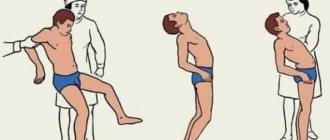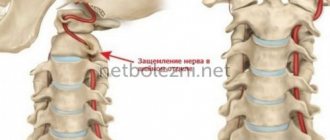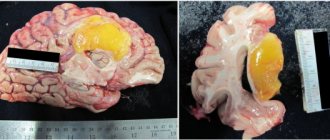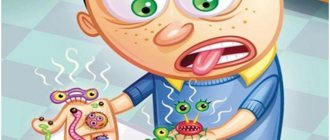Anxiety disorders are a common mental illness. Pathologies of this type do not belong to the group of severe ones. They are not accompanied by psychotic manifestations and behavioral disorders, but when they reach serious proportions, fears not only worsen the quality of life, but can pose serious problems for a person.
What is an anxiety disorder
Anxiety is a person’s tendency to worry. Many people experience anxiety before any important events or activities, and such worries are quite natural. Medical attention is required in cases where anxiety and fear occur for no apparent reason. A human condition accompanied by uncontrollable fear and a persistent feeling of anxiety is called an anxiety disorder (AD). Under the influence of anxiety, a deterioration in concentration is often observed, and a person often falls into depression. In most cases, the disease is completely curable. If you do not seek help from a doctor, the risks of complications and the occurrence of depressive disorders and pathological addiction increase.
Causes of anxiety
Why does anxiety occur and where does it come from? The amygdala, an area of the brain, is responsible for human emotions. As a natural adaptive reaction, every person has anxiety, but not everyone has anxiety disorders. According to numerous studies, experts identify several main factors that provoke the development of an anxiety disorder:
- hereditary predisposition;
- characteristics of upbringing and the prevailing atmosphere in the family;
- frequent traumatic situations;
- somatic diseases;
- inability to overcome crisis situations;
- self-dissatisfaction, low self-esteem and other internal conflicts;
- disruption of thinking processes.
Excessive consumption of alcohol, strong coffee, lack of sleep, and frequent stress make the human autonomic system more sensitive and increase the risk of developing anxiety disorders.
Neurotic syndromes
They are characterized by the appearance of various functional disorders that do not interfere with the correct assessment of real events, one’s condition and behavior. We will describe the following neurotic syndromes: obsessive-phobic, anorexia nervosa syndrome, neurotic depression, hypochondriacal syndrome, hysterical symptom complex, personality reactions to illness. The mentioned neurotic phenomena arise against the background of various somatized disorders of sleep, autonomic regulation, well-being, appetite, etc.
Obsessive-phobic (anankastic) syndrome. It includes different types of obsessive disorders: intellectual obsessions (obsessions), motor (compulsions or impulses) and emotional (phobias, doubts, fears). Most often it occurs against the background of a depressed mood, which corresponds to the mostly joyless, anxious, and sometimes painful content of obsessions. Obsessions can occur periodically if they are associated with phasic depressive states - atypical depression (more precisely, depression with obsessions). Cases of a combination of obsessive disorders with hypomanic mood swings are relatively rare. The content of obsessions changes to the opposite. The experience of obsessions as painful, overwhelming and alien phenomena in this case becomes duller, and their content becomes more optimistic.
| |
Types of Anxiety Disorders
Depending on the symptoms caused by anxiety and fear and the level of severity of the pathology, experts distinguish several types of anxiety disorders.
Panic disorder
People suffering from this type of illness experience a sudden and repeated feeling of horror. They occur even in the absence of specific events or emotional upheavals. Intense sweating, increased heart rate, dry mouth, feeling of suffocation, dizziness and lack of understanding of current realities are the dominant signs of panic disorders.
Social disorder
This type of pathology is also called social phobia. The disease manifests itself through the fear of getting into an awkward situation, the fear of becoming humiliated or the object of criticism. Often such anxiety is caused by low self-esteem. Sudden attacks can occur almost any time and anywhere - during group activities, while in a shopping center, cinema and other public places, when talking with a well-known person in the presence of strangers and other situations. When an anxiety attack occurs, facial flushing, nausea, hand trembling, and uncontrollable urges to urinate occur. The patient himself understands that his reaction is causeless and excessive, but he cannot control himself.
Adaptive phobias
These are anxiety and fears that arise in a specific specific environment. An attack can occur when a person is near animals of a particular species (for example, snakes), while in a confined space, at a height, or in the dark. Fear of air travel and medical procedures also belong to the group of specific phobias. When a person encounters a frightening stimulus, he immediately triggers anxiety, which manifests itself with corresponding signs. If the disease is not cured in a timely manner, then soon the person will simply limit himself to a full life.
Generalized disorder
It is expressed by sudden anxiety about any event, the likelihood of which is not justified and may not occur at all. With this type of illness, anxiety is not limited to any specific circumstances, so it is difficult for a person to determine the most dangerous situations for him. People suffering from generalized TR experience tachycardia, muscle tension, trembling, sweating, and dizziness. To make a diagnosis, such symptoms must continue for at least six months.
Agoraphobia
This is a group of TP, which simultaneously includes several phobias that combine the fear of crowded public places, as well as open spaces. For example, when visiting a store, being in a large crowd or in other crowded places, a person experiences anxiety. It manifests itself as palpitations, difficulty breathing, profuse sweating, and dizziness. Some people even have a panic attack.
Post-traumatic stress disorder
Occurs as a consequence after an extreme situation, for example, after rape, a natural disaster, an accident, abuse or bullying and other shocks. It manifests itself as sleep disturbance, increased heart rate, sweating, and suffocation.
Emotional disorders
This type of TR is typical in childhood. Panic may arise as a result of prolonged separation from parents, after severe emotional shock, or as a result of parental abuse of the child. It often happens that, not knowing how to eliminate an anxiety attack, a parent increases their anxiety even more.
Situational anxiety
A sudden change of events causes discomfort in a person. For example, dismissal from work, unplanned forced relocation, divorce and other life events. Everyone may have their own reasons, and one person may experience fear in a situation in which another does not react to it at all.
How does fear neurosis arise and what is it?
This phenomenon always contains a certain component - a situation or object that constantly causes fear (in milder cases, only when a person actually encounters this object/situation; in other, less mild cases, when the patient only needs to imagine them).
While there are a huge variety of phobias, the most common are those that are related in theme to health or position/physical location in a certain situation. So, as an example to illustrate the first group, we can cite the fear of getting cancer, fear of infection, death, etc. The second category of common phobias includes claustrophobia (fear of enclosed spaces), agoraphobia (the opposite phenomenon - fear of open spaces), depths, heights and others.
Often, phobic neurosis can be expressed in the desire to avoid a frightening situation, to protect oneself from it by all means. And then various kinds of rituals arise, which directly (for example, the ritual of drinking 5 nitroglycerin tablets every night for cardiophobia) or indirectly (counting the illuminated windows in neighboring houses before going to bed for the same phobia) are designed to protect a person. However, the trouble is that avoidance and rituals of protection bring only a temporary state of relief, and in the end only worsen the neurosis of fear.
Main symptoms of TR
All possible signs of TR are divided into physical and psychological. Physical symptoms include:
- rapid pulse;
- labored breathing;
- dizziness and headaches;
- feeling of tightness in the chest;
- shiver;
- heartache;
- numbness of the limbs;
- increased sweating;
- pain in the stomach, heart;
- nausea;
- hot flashes;
- violation of thermoregulation;
- insomnia;
- general weakness.
Psychological symptoms include a feeling of fear, insensitivity to reality, disorientation, and causeless panic.
Neurotic disorders
All neuroses are accompanied by emotional, psychological and autonomic disorders. Autonomic symptoms include lightheadedness, dizziness, a feeling of unsteadiness, trembling limbs, muscle twitching, muscle cramps, increased heart rate, pain and discomfort in the chest, increased or decreased blood pressure, feelings of cold or heat, sensations of suffocation, lack of air or incompleteness. inhalation, yawning, appetite disturbances, various dyspeptic disorders, frequent urination, pain, itching and discomfort in the perineum, sweating, chills and a slight causeless increase in temperature. Characteristic features of autonomic disorders are their instability and polysystemic nature.
In all neurotic disorders, sleep disturbances are observed: difficulty falling asleep due to thoughts associated with a traumatic situation, or due to an overly acute perception of any external signals (ticking clocks, street noise, sounds of neighbors' footsteps), frequent awakenings, shallow sleep, vivid or nightmare dreams, feeling weak and exhausted after a night's sleep. Often the patient suffers from drowsiness during the day and from insomnia at night.
Another obligate sign of neuroses is asthenia. Patients do not tolerate stress well and quickly become exhausted. Neurotic disorders are accompanied by mood instability, irritability and decreased performance of varying degrees. The sexual side of the patients’ lives also suffers - sexual desire disappears or decreases, the duration of sexual intercourse decreases, sexual contacts do not bring the same satisfaction, various disorders arise (potency disorders, premature ejaculation).
In neurotic disorders, affective disorders are observed. The general background of mood decreases, patients feel sadness, melancholy and hopelessness. Habitual pleasures (delicious food, hobbies, communication with friends and family), which previously brought joy, become indifferent. The range of interests narrows, patients become less sociable and begin to avoid contact with other people. Depression or subdepression often develops. The level of anxiety increases. Patients see the future as unfavorable and unfavorable. They live in anticipation of an uncertain catastrophe and tend to overly concentrate on negative scenarios.
In contrast to the above manifestations of neurosis, obsessions and phobias do not occur in all patients. These two signs are closely related, but in the clinical picture, as a rule, one of the two symptoms predominates. Obsessions are involuntary, intrusive thoughts, urges, fears, or memories. To get rid of obsessions, patients perform compulsive actions, often taking the form of complex rituals.
Phobias are obsessive fears of objects or situations that currently do not pose a real danger to the patient. There are three types of phobias: simple phobias (isolated fears of spiders, flying, birds, clowns, etc.), agoraphobia (fear of open spaces, places that cannot be left unnoticed, and situations in which you can be left without help) and social phobia (fear of situations , in which the patient is the center of attention of others).
TR treatment methods
A psychotherapist treats anxiety disorders in patients. Treatment options include medications, therapeutic modalities, and changes in the person's lifestyle.
Therapeutic treatment
TR treatment begins with a conversation between the doctor and the patient. During the conversation, the nature of anxiety is assessed, and factors that alleviate and aggravate the pathology are determined. For anxiety disorders, cognitive behavioral and psychotherapy provide good results. When conducting sessions, special psychological techniques are used to help the patient make changes in his behavior, thoughts and feelings that help get rid of fear and anxiety and aimed at recovery. It should be understood that the main cause of anxiety is often a psychological problem, therefore, without an individual course of psychotherapy, it is difficult to achieve recovery and the disease will return again and again. The psychotherapist will teach the patient to change negative emotions and thoughts to positive ones, to get rid of feelings that provoke anxiety attacks.
Drug treatment
Taking medications usually begins simultaneously with psychotherapeutic treatment. Pharmacological therapy includes:
- antidepressants. They normalize mood, relieve emotional stress, irritability, anxiety, apathy;
- anti-anxiety or anxiolytics. Suspends and prevents acute attacks of fear and panic;
- sedatives. They have a calming, relaxing effect and normalize sleep.
In each case, drugs are prescribed based on the patient’s personal characteristics (gender, age, concomitant diseases) and clinical picture.
Lifestyle change
If a person wants to get rid of anxiety disorders forever, then along with therapy and drug treatment, he needs to exercise daily, monitor the normalization of sleep, eat right, reduce caffeine consumption, and give up bad habits. A big plus for achieving a positive result will be quitting smoking.
Preventive measures
In order to prevent fear neurosis, it is recommended:
- maintain a sleep and rest schedule, as well as a balance between physical and mental activities;
- eat healthy foods rich in vitamins;
- engage in sports and self-development;
- to refuse from bad habits;
- start a hobby;
- regularly communicate with people in person.
Fear neurosis is a serious disease that must be diagnosed promptly and treated, otherwise it can lead to adverse consequences. However, you need to understand that this disease is not incurable. With the right frame of mind, it retreats and the person gets rid of his fears. The correct choice of a specialist with whom the patient will develop a trusting relationship is of great importance.
Treatment of anxiety disorders in
Psychotherapists strongly recommend that everyone pay attention to their psychological state and, if even minor deviations from the norm are detected, seek professional help. Any increased anxiety that lasts for several hours or even several days is already a reason to consult a doctor. The psychotherapeutic center employs experienced psychotherapists who can help anyone in the treatment of anxiety disorders. When working with a patient, doctors use an integrated approach, combining pharmacotherapy and psychotherapy. This allows you to achieve positive results in the most difficult situations. Benefits of treatment in:
- accurate diagnosis in accordance with international standards;
- 100% effectiveness and safety of treatment;
- complete confidentiality;
- affordable price.
Doctors help patients get rid of anxiety disorders forever, even in the most hopeless situations. The prices for treatment are reasonable and justified by the quality of the services provided.










